![]() Sometime around 1975-76 I wanted an MXR Phase 90 for my Wurlitzer electric piano – I wanted what the ‘real’ keyboard players of the time were using. Instead, I bought the cheaper Electro-Harmonix Small Stone, believing it to be the poor man’s alternative. I was wrong.
Sometime around 1975-76 I wanted an MXR Phase 90 for my Wurlitzer electric piano – I wanted what the ‘real’ keyboard players of the time were using. Instead, I bought the cheaper Electro-Harmonix Small Stone, believing it to be the poor man’s alternative. I was wrong.
That both effects have since become effects icons and remain in production today is a clue to just how wrong I was…
The Phase 90 was MXR’s first pedal, released in 1974 – the same year that EH put out the Small Stone. These pioneering pedals followed the lead set by the PS-1A desktop and MP1 footpedal phasers released by Maestro in 1971, in the earliest stages of the Stompbox Big Bang.
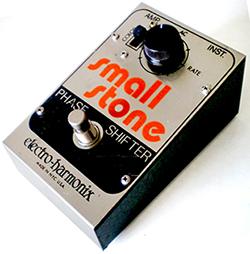
The novelty of phasing wore off, but phasers have endured within the stable of musicians’ effects. Obvious examples of their use on guitar include Led Zeppelin’s ‘Kashmir’, Van Halen’s ‘Ain’t Talkin’ ’Bout Love’ and Tame Impala’s ‘Solitude is Bliss’. You can even find a phaser on the Sex Pistols’ ‘Anarchy in the UK’. The early 1970s also threw up the unmistakeable Roland AP-7 Jet Phaser, made infamous by the guitar solo in the Isley’s ‘Who’s that Lady’.
On keyboards, you could count almost anything Donald Fagen played on Fender Rhodes with Steely Dan or the swept strings on Tangerine Dream’s Phaedra.
Take the Stage
The first thing to know about the internals of phasers is how many stages they use to achieve the phasing effect. The Phase 90 and Small Stone are both four-stage phasers, but others offer two, six, ten, 12 or 16 stages. And, uniquely, the lavishly-featured Empress Phaser offers an odd three stages. Stages create notches between them that selectively cancel out the audio leaving peaks between them – one notch per pair of stages, with more notches creating a more pronounced effect. These stages are all-pass filters that are made time variant by an oscillator governed by the speed/rate control. (Where the even spacing of a flanger’s peaks produce coherent harmonics, the phaser’s peak locations are not harmonically related.)
MXR covered two, four and six stages with their Phase 45, Phase 90 and Phase 100 pedals. As well as being common among stompboxes, phasers are a regular part of large modular synthesiser systems – the current Moogerfooger MF-103, with its switchable 6-stage or 12-stage circuit, brings classic Moog modular phasing to the feet of guitarists.
Today, there are countless phasers available ranging from cheap generic units to boutique pedals, such as the rich Red Witch Moon Phaser (fusing phasing and tremolo), the Midi-enabled Chase Bliss Audio Wombtone MkII and valve-based Phaseomatic Vacuum Tube Phaser. Phasing is also a staple of all modulation modellers and guitar multi-fx units (such as Boss' GT100, Line 6's M13 and M9, the Fractal AX8 and TC's Nova system). Among these, the Strymon Mobius modeller is particularly worthy of mention.
This is not because its feature set offers any number of stages or that there are four additional LFO waveforms over the mandatory sine wave – which it does. Rather, it is for its Barber Pole phasing – more usually the prerogative of modular synthesis. Otherwise known as a Shepard-Risset illusion, this creates the effect of phasing that is continually ascending or descending in pitch – analogous to the Penrose Stairs optical illusion used by the Dutch artist, MC Escher.
Steps in Time
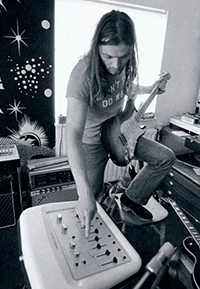 Against this onslaught of pretenders to their crown, both the Small Stone and Phase 90 have resolutely held their ground.
Against this onslaught of pretenders to their crown, both the Small Stone and Phase 90 have resolutely held their ground.
By my count, Electro-Harmonix has issued no fewer than eight versions of the Small Stone (some branded Electro-Harmonix/Sovtek when the company went bankrupt in the US and re-established itself in Russia, adding to their mystique) and a Nano version. These have appeared in the original ‘wedge’ casings in various liveries, as well as the ‘pedal standard’ (Hammond 1590B) box.
The Small Stone was designed by former EMS engineer David Cockerell, and was based on his work on the EMS Synthi Hi-Fli, as used by David Gilmour on the Dark Side of the Moon recording sessions. It sets itself apart from most designs in that it uses transconductance operational amplifiers instead of the more usual op-amps and variable resistors.
For its part, the Phase 90 has developed a schizophrenic identity with its ‘script’ and ‘block’ incarnations – referring to differing panel screening as well as circuitry. Jim Dunlop acquired MXR in 1987, under whose ownership the EVH90 model appeared, the result of a collaboration with Eddie Van Halen, who had used the Phase 90 extensively on the first two Van Halen albums.
The MXR Variphase followed, placing Phase 90 electronics inside a Cry Baby housing for foot control of the speed. More recently, the 45/90 has packed switched options of Phase 45/Phase 90 and Script/Block settings into a ‘fishfinger’ (1590A) casing. And while Phase 90 clones like the Mooer 90 Orange aren’t difficult to find, Whirlwind’s Orange Box is a hand-wired reissue that claims to be from its original designer.
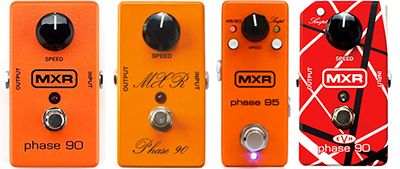
Rose Marie Sherwood is quoted as disputing the role of Whirlwind’s Michael Laiacona in the Phase 90’s design, however. She says that her husband Terry and Keith Barr (who later founded Alesis) were MXR’s founders and pedal designers, while Laiacona ‘was one of the early employees and would take... finished products and demonstrate them to his musician friends’.
Another phaser with ‘legendary’ status is the Mu-Tron Bi-Phase from 1973 – this was a development of the Phasor II that used two independent phasing circuits and LFOs, with lamps and photocells like the Uni-Vibe. ‘That helped give the Phasor its own sound because photo resistors don’t track each other exactly and each has its own particular time constant and subtle form of nonlinearity,’ designer Mike Beigel has said. ‘We even had a special photo mod custom made for us with six photocells in it.’
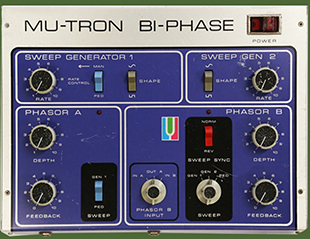
With the Maestro sound in his sights, Beigel recalls the early circuit being too clean: ‘In audio terms ours was too good, but in musical terms it wasn’t good enough. I put a feedback control around the phase-shift loop so that, instead of distorting the signal, it emphasised the peaks where the phase shifter didn’t cancel the signal.’
Now long out of production, the Bi-Phase has become a prized pedal in recording studio circles, and has notably been used by Smashing Pumpkins and producer Butch Vig. Today, there is a Bi-Phase copy called the Pi-Phase from Australian company Prophesysound, that reckons to be an ‘accurate reproduction’ of the original.
Bi-Phase is also among the models to be found on the Line 6 MM4 and the modulation options on offer on the Eventide ModFactor (and notably absent from the Mobius). Neither properly map the full extent of the Bi-Phase routing and modulation possibilities, but both take their phasing beyond the sound of a single-oscillator, single-sweep phaser. With the MM4, this is done with a single speed control for a compound modulation waveform, while the ModFactor has two modulation sources at its disposal and sounds pretty convincing.
In common with a good number of modern phasers, the MM4 and Modfactor also have stereo outputs. Running a guitar rig in stereo would have been well beyond the scope of the early pedal designers, but can add considerably to the effectiveness of phasing.
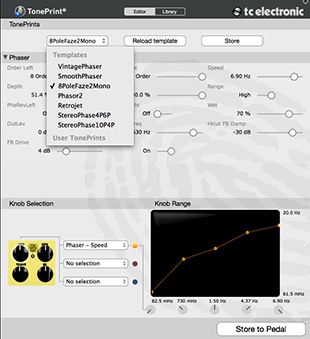
I inherited a Mu-Tron Phasor II somewhere along the road – the precursor to the Bi-Phase, with its single six-stage circuit using transconductance op-amps. It will give distinctive dramatic phase sweeps but perhaps its most appealing trait is that, at more subtle settings, it just becomes an integral part of your guitar sound.
More recently, getting my hands on TC Electronic’s Vintage Vibe (see The Vibe Revival) prompted me to check out TC’s Helix phaser. Apart from popping up in various ‘top phaser pedal’ listings, this is significant as it is in part modelled another ‘classic’ – the TC XII Phaser from 1976, which offered 4/8/12 stage switching and a variable modulation waveform, and was one of TC’s first stompboxes.
Helix offers Vintage and Smooth phase characters, as well as TC’s TonePrint editing – direct editing of a digital model of classic analogue phasing. Opening up the Toneprint editor for Helix on my Mac revealed five further templates alongside Vintage and Smooth, as well as control over the number of stages, filtering and the respective phases of the two outputs among other parameters. Editing is interactive with the pedal, and the result can be saved under the TonePrint switch.
Genuine MXR or Electro-Harmonix circuitry, Helix clearly is not. But a wealth of classic and current phasers’ characters it is – and it gave me more than passable impressions of both my Small Stone and the Phase 90 that I once sought.
Before disappearing somewhere along the way, that undervalued Small Stone was joined by two original Japanese Ibanez phasers (on ElkaRhapsody string synth and Micromoog), while it found a happy place on my D6 Clavinet alongside an Electro-Harmonix Doctor Q. The Wurlitzer, meanwhile, got a secondhand MXR Phase 45. I greatly regret selling the Phase 45, but I still have the – now collectable – Ibanez pedals. I never got my Phase 90...

